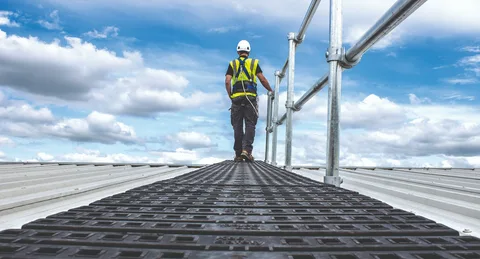Introduction
In New York City construction and building maintenance projects, the role of scaffolding companies is critical. These firms provide the access, protection, and temporary structures needed for work at height across facade, roof, exterior, and interior zones. A strong understanding of their services, regulatory context, and selection criteria is essential for contractors, property owners, and facility managers.
Topical Map Overview
Subtopics and Semantic Context
-
Types of scaffolding systems in NYC such as frame, system, suspended, and sidewalk sheds
-
Sidewalk shed and pedestrian protection structures
-
Regulatory environment including New York City Department of Buildings DOB rules, inspections, Local Law 11, and New York Building Code
-
Service lifecycle such as design, engineering, installation, inspections, and dismantling
-
Safety, liability, insurance, and compliance
-
Choosing a company based on credentials, equipment, reviews, and scope
-
Cost drivers and logistics in NYC urban environment
-
Borough specific challenges such as those in Manhattan, Brooklyn, Bronx, and Queens
-
Storage, logistics, hoists, and special purpose scaffolding
-
Industry trends such as sustainability and material reuse
Core Entities and Their Attributes
-
Entity: Scaffolding Company
Attributes: licensed, insured, equipped, experienced, handles permits -
Entity: Sidewalk Shed
Attributes: pedestrian protection, permit required, located in high traffic area -
Entity: Suspended Scaffold
Attributes: used for facade work, high rise access, powered by hoist systems -
Entity: NYC DOB
Attributes: permit authority, inspection body, enforcement agency -
Entity: Local Law 11
Attributes: periodic facade inspection rule, often triggers scaffold requirement
Types of Scaffolding Services in NYC
Frame and System Scaffolding
Standard modular systems used for midrise facade work or interior access
Suspended and Swing Stage Scaffolding
Used for high rise exterior work where ground erection is impractical
Sidewalk Sheds and Pedestrian Protection
Crucial in dense areas like Manhattan where pedestrian safety is legally mandated
Hoists Shoring and Specialized Access
Used for heavy load transport, building support or tight space maneuvering in older or unique buildings
Regulatory and Safety Framework
Compliance with DOB regulations is mandatory. For example:
-
Scaffolds must be installed by insured professionals and inspected periodically
-
Sidewalk sheds usually require a permit and must meet safety and design specifications
-
Facade inspection mandates such as Local Law 11 often require the installation of scaffolds and sheds
Noncompliance can result in violations or project shutdowns
How to Choose a Reliable Scaffolding Partner
Key evaluation factors include:
-
Licensing and insurance
-
Experience with similar projects
-
Comprehensive service offerings
-
Ability to manage DOB permits and local logistics
-
Equipment quality and crew safety record
-
Understanding of borough specific access and zoning conditions
Cost and Logistics in the NYC Context
Main cost drivers:
-
Project height and access complexity
-
Need for sidewalk shed and pedestrian protection
-
Duration of equipment rental
-
Access challenges such as staircases or narrow streets
-
Location premium in boroughs like Manhattan
Logistical barriers include loading zones, permit scheduling, and street closures
Case Usage and Best Practice Scenarios
-
Facade repair on Manhattan midrise: needs shed, night work, weekly inspections
-
Highrise window install in Brooklyn: requires suspended scaffold, loading dock use
-
Apartment renovation in Bronx: simpler scaffold, less foot traffic, still DOB oversight
Trends and Industry Outlook
-
Sustainability focus with reusable materials and minimal disruption
-
Digital logs for scaffold inspections
-
BIM integration to improve planning
-
Increased safety enforcement
What do scaffolding companies in NYC offer?
They provide scaffolding design, installation, inspection, and removal for construction and maintenance projects.
Is a permit required for scaffolding in NYC?
Yes, most scaffolding, especially sidewalk sheds, requires a permit from the NYC Department of Buildings.
What is a sidewalk shed?
A sidewalk shed is a temporary structure built over sidewalks to protect pedestrians from construction debris.
Who regulates scaffolding safety in NYC?
The NYC Department of Buildings regulates scaffolding safety and compliance with city building codes.
How long can scaffolding stay up in NYC?
It can remain as long as needed, but must be regularly inspected and maintained to meet safety standards.
Do scaffolding companies provide engineering services?
Many offer scaffold engineering and design to meet project specifications and DOB requirements.
What types of scaffolding are used in NYC?
Common types include frame scaffolds, system scaffolds, suspended scaffolds, and hoist towers.
Can scaffolding be used for residential buildings?
Yes, scaffolding is used for both residential and commercial building maintenance or construction.
How do I choose a reliable scaffolding company in NYC?
Check for licensing, insurance, project experience, safety records, and customer reviews.
What are the cost factors for scaffolding in NYC?
Costs depend on project height, duration, type of scaffold, location, and permit requirements.
Summary and Key Takeaways
Scaffolding companies in NYC are vital to safe and legal construction projects. By understanding scaffold types, regulatory requirements, and logistical barriers, contractors and property managers can select the right provider. The best companies combine compliance, local knowledge, and tailored service to meet the demands of NYC’s dense and high pressure building environment.



